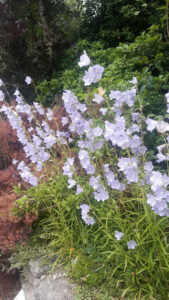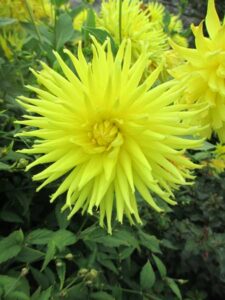Gardening
with Charlie Wilkins
THE MAY GAP
A shelf of gardening books is like an attic of memories and forgotten stories! I wanted to look up ‘lilac trees’ now that we have entered May but could not find a single tome which could name a few modern varieties. My search was prompted by the arrival of the ‘May Gap’, a period between the spring bulbs-which have pretty much done their stuff by now- and the arrival of the herbaceous heavies. My favourite heavies include lupins, delphiniums, alstromeria, and early clematis, along with a Trinity of May delights: columbine, peony, and lily of the valley! You do not have a May Gap? Then you are wise indeed and have planned for late cherries, wisteria, the golden rain tree (the American name for Laburnum) and wonderfully scented lilac. I commend and admire your wisdom and choices, but have you included those devotees of shadowy places: hybrid azaleas and choice rhododendrons? Perhaps not, so now is the ideal time to plan a change and to indulge perhaps in a tremendous gamble! You may embark with timidity on the purchase of these woodland gems (and watch over them with trepidation until they bloom) but be assured that they will bring rewards in abundance over many, many years.
There is something obsessive about these exotic shrubs! Gentlemen love them but the ladies are first to notice their muted pastel shades and powerful scent. Indeed, I have never met a gardener, male or female, who was disappointed with azaleas. Of course, if you love them and have the right kind of lime-free soil, the scope is joyous. Even if your soil is alkaline, you can still grow them in suitable tubs and containers or in specially dug and prepared planting holes (separated from the surrounding soil by a vertical lining to the sides of the hole with polythene) in any half-shaded spot. Fill this hole with a lime-free medium; leaf-mould, pine-needles, garden compost or used potting compost.
I would like to tempt you with one or more Ghent azaleas which have fragrant long-tubed, honeysuckle-like flowers. No variety will be found less than good. The Knaphill and Exbury hybrids have a heavenly range of colours and the Mollis azaleas bloom early this month before their leaves appear. I still thrill at the sight of the soft rose-pink colours found on the likes of ‘Berryrose’ and the whites with just a touch of yellow such as ‘Persil’. Surely you remember me mentioning this last variety on more than one occasion in the past. In the twenty and more years it has stood in the front garden it has never failed to impress either in the perfection of its blooms or intense perfume.
Nearby grow wide, fat, dumpling-shaped specimens of evergreen azalea ‘Vuckys Scarlet’ ‘Blauw’s Pink’ and ‘Adianthum’ in sky blue. They need neither attention nor coddling from year’s start to finish and this includes my regime of absolutely no pruning. They just do not need it, all being tidy, compact growers.
Many of the above and a host more are in flower now in garden centres. ‘Hillside’ has a fine selection so think about a purchase and plant as soon as the soil and weather permit.

SUNDAY MISCELLANY
Sunday morning in April, a day of special beauty caught between the heat of recent days and the threat of night frosts. I am sitting in a pleasant warmth beneath a yellow-leaved small garden tree called Gleditsia triacanthos ‘Sunburst’, planted when I first came to live at Villa Marie. Just now, in the high spring light and rising temperatures it shimmers and glows, and it is certainly the loveliest thing in the garden. The bottom half is in light shadow whilst the upper canopy of tiny, fern-like leaves flutter in the faintest movement of air. Under this gentle shade, I wander back in thought to other summer days, in particular my childhood summers and I become lost in reverie. In my mind’s eye I can see the creeks and streams and swimming holes of long ago. Memories come flooding back of bare feet on dew-fresh grass or paddling in shallow rivers, tadpoles, and sticklebacks swimming between my toes. What child today could identify with this, or the challenge of bird nesting, hunting for wild fruits and giant mushrooms, or rushing to collect timber for a midsummer bonfire? Two blue tits rush into the yellow canopy barely feet from my face. I know these birds, their diet, habit, and choice of nesting site. Nowadays, most youngsters are just about able to recognise and distinguish crows from pigeons! Identification of blue tits, yellow hammers, robins, siskins, even the thrush would be out of the question.
My friends and I lived intently then, holding nothing back. We ate on the hoof; huge slabs of bread and jam washed down with jam jars of water taken directly from the streams. Late spring then was a celebration of life and the earth was our table. Suddenly the blue tits are off, and the sudden drop in temperature brings me back to reality. I long for a short downpour if only to refresh the wilting flowers.
THE MAY GARDEN
This is the weather the cuckoo likes, and so do I, but the days and nights are still cold (as I write) and our winged visitor from South Africa has yet to be spotted. However, the shadows continue to shorten and the church spire, which, since early autumn has acted like a sundial genome, no longer casts a spire-like image across the lawn.
As in every year, the mower is now out of the shed, smoking and roaring like a grumpy old motor. For the next six months my trusty model will be expected to do the job of two horses, four cows, even half a dozen sheep! It will not look for food, compliments for a job well done, or shade from hot sun. So, look after your lawnmower!
TIME FOR TOMATOES
I cannot stress too strongly the value one will get from a basket variety of tomatoes sourced from Dooley’s here in Riverstown. Bought now and kept frost free until hanging-out time later this month, the investment will give small, sweet fruits from the end of June through to the closing days of October. Give full sun, water diligently especially in dry periods, and feed weekly with any tomato food.







